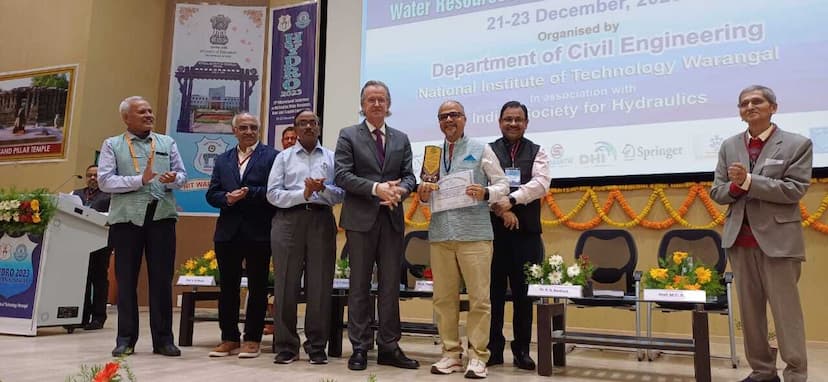IIT Guwahati BRAHMA-2D Model Revolutionizes Hydraulic Design for Sustainable River Management

IIT Guwahati researchers led by Prof. Arup Kr Sarma in collaboration with the Brahmaputra Board, Ministry of Jal Shakti, Government of India have developed an indigenous river model BRAHMA-2D (Braided River Aid: Hydro-Morphological Analyzer).
This comprehensive mathematical model can help to understand flow of large braided rivers like Brahmaputra, providing valuable insights to field engineers to design sustainable hydraulic structures like Spurs, Revetment and other river bank protection measures.


Prediction
Predicting river flow variations across depth is crucial for flood and erosion control, agriculture and water supply intake design, and zero head energy production, say sources from IIT Guwahati.
Traditional measurement methods of flow velocity in deep, large rivers during high monsoons is risky and extremely difficult, prompting the use of mathematical models, say IIT Guwahati researchers.
However, existing models provide only average velocity, underestimating undercurrents at different depths, say IIT Guwahati researchers.

In braided rivers, the presence of sandbars further complicates accurate three-dimensional velocity computation.
Model
Speaking about the BRAHMA-2D model, Prof Arup Kr Sarma, Department of Civil Engineering, IIT Guwahati, said their mathematical model combines highly complex mathematical modelling with challenging field-based research on large braided rivers.
With this quasi-3D river flow model, we can understand how fast the water moves at different depths inside a river and its circulation around a structure like a spur installed for prevent river bank erosion, said Prof Arup of IIT Guwahati.

Integration
BRAHMA-2D integrates a two-dimensional model of water movement with a theory about entropy, a measure of disorder or randomness, say sources from IIT Guwahati.
The research also delves into how features like river banks, spurs, and sandbars affect the way water moves.
Specifically, it observes a dip phenomenon near spurs where the flow of water underneath increases, a phenomenon absent in points away from these structures.


The award ceremony took place on 21st December 2023 at the Hydro-2023 conference hosted at NIT, Warangal. The paper has been co-authored by Prof Arup Kr Sarma and his former research scholar Dr Anupal Barua.
Validation
The model was successfully validated on the Brahmaputra River near Majuli Island, the second largest freshwater river Island in the world, prone to river bank erosion, say sources from IIT Guwahati.
Application
Dr Anupal Baruah, at present working as post-doctoral fellow at the University of Alabama, USA, highlighted the model’s successful application with the river survey data.
It uses GPS Echo-Sounder for depth and Acoustic Doppler Current Profiler, along with current meters for velocity measurement.
He emphasized, “During my research at IIT Guwahati field measurements near the spurs revealed a strong agreement with our model results.

The versatile model has further helped to design bioengineering methods for controlling river bank erosion, say sources from IIT Guwahati.
It has also been applied to understand habitat suitability of aquatic species, especially endangered species, based on the availability of required depth and flow velocity.
This breakthrough can now be applied to compute the vertical velocity profile at any desired location, say sources from IIT Guwahati.
IIT Guwahati
Indian Institute of Technology Guwahati, established in 1994, completed 25 years of glorious existence in 2019.
At present, the Institute has eleven departments, nine interdisciplinary academic centres and five schools covering all the major engineering, science, healthcare, management, and humanities disciplines.
It offers BTech, BDes, BSc(Hons), MA, MDes, MTech, MSc, MS(R), MBA and PhD programmes. The institute offers a residential campus to 439 faculty members and more than 8,600 students at present.
S Vishnu Sharmaa now works with collegechalo.com in the news team. His work involves writing articles related to the education sector in India with a keen focus on higher education issues. Journalism has always been a passion for him. He has more than 10 years of enriching experience with various media organizations like Eenadu, Webdunia, News Today, Infodea. He also has a strong interest in writing about defence and railway related issues.






